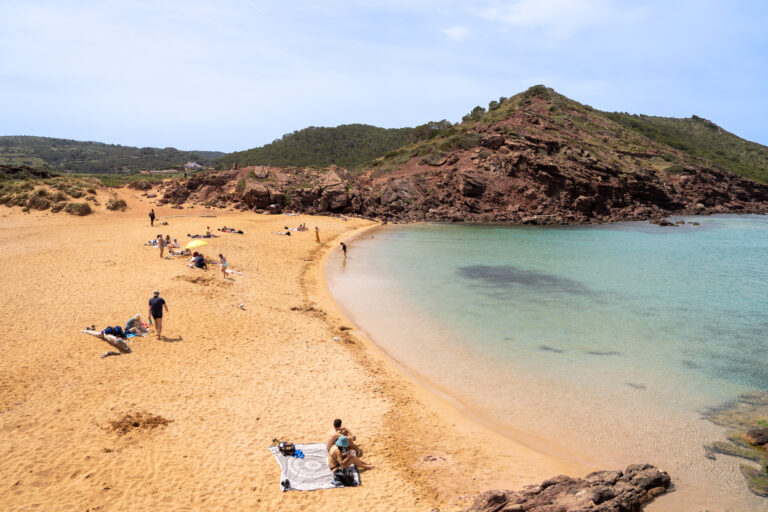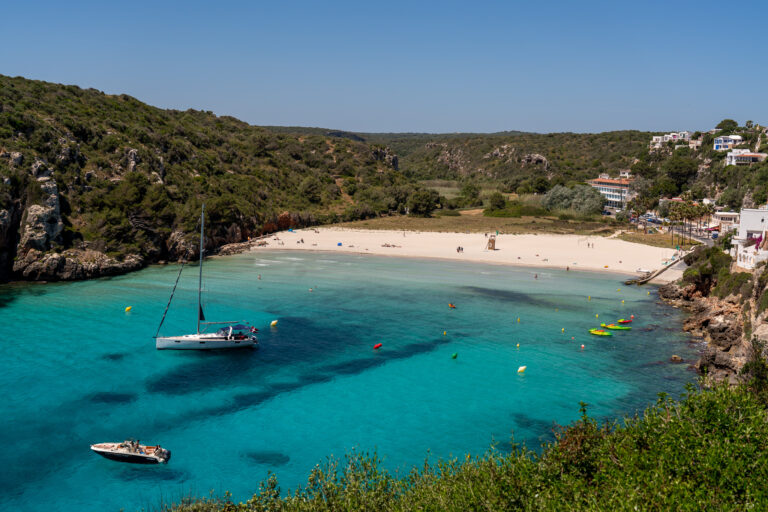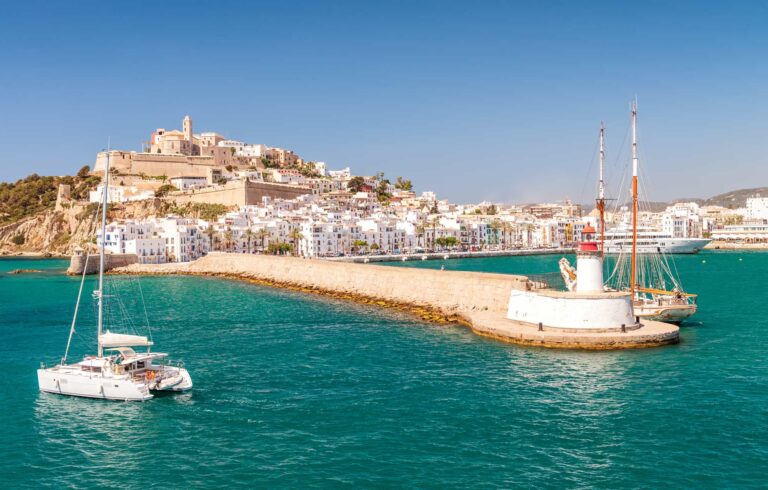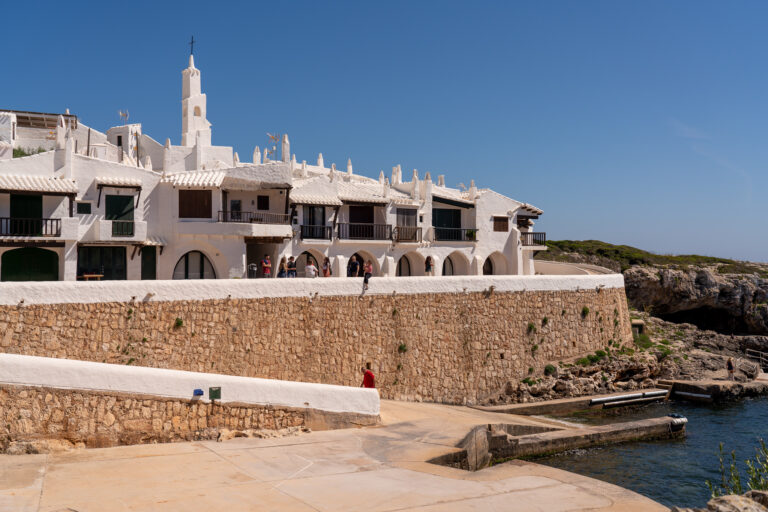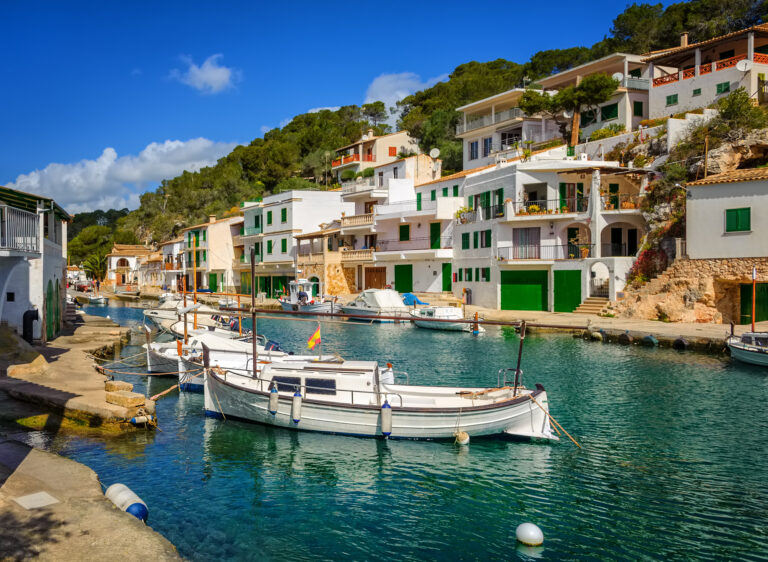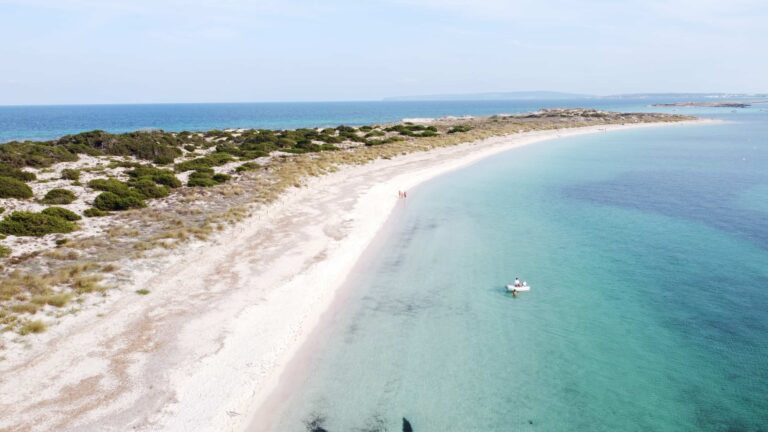Visiting Alaior | Menorca’s Market Town
The town of Alaior in Menorca is often overlooked by visitors, who instead flock to the pretty coastal resorts and larger cities on the island. However, this interior market town has a unique charm of its own, one that harks back to a bygone era.
Wander through the historic centre, admiring the Baroque and Renaissance architecture of convents and churches. Enter a local art gallery, showcasing contemporary works by global artists, or browse weekly street markets for handmade crafts, antiques and fresh local produce.

In Alaior you can dine on rustic Menorcan cuisine in casual restaurants, hike to abandoned quarries and ruins of ancient Talayotic settlements or take the kids to feed donkeys at a local rescue centre.
And if the seaside beckons, beautiful beaches are just 15 minutes away by car, with soft white sands and turquoise waters for swimming and snorkelling. So, if you’re interested in making Alaior your Menorcan base, here are a few ideas to help elevate your stay.


A Brief History of Alaior
The first inhabitants of Menorca settled near Alaior between 2200 and 1000 B.C. This is evidenced by the stone burial navetas and Talayotic settlements located in the area.
However, it wasn’t until centuries later, after the Catalan/Aragonese conquest of Menorca that the town really began to take shape.

In the early 1300s, Mallorca’s King Jaume II purchased an old Arab farmstead known as Ilhalor – from which the town’s current name Alaior is derived. A church, Santa Eulalia was built, and the town began to expand around it.
One of the most prominent buildings to arise was the University of Alaior – not a teaching centre, more of a government office. By the mid-1600s it had the power to organise its locale and collect taxes from citizens, independent of the state.


By the 19th century, Menorca came under Spanish rule once more. The universities were replaced by town halls, and the industrial era began, with Alaior increasingly making a name for itself in the realm of shoemaking.
Fast-forward to the 1950s, and the town’s main industries – shoe manufacturing, cheese-making and metalwork began to thrive. In the years that followed, local art and craft shops emerged, and agro-tourism hotels were built to attract new visitors, creating the Alaior we see today.

Getting to Alaior
If you’re renting a vehicle in Menorca (and I would suggest you do), you can drive to Alaior along the Me-1 from Mahon and Menorca Airport in under 20 minutes, and from Ciutadella in 35 minutes.
Visiting from Arenal d’en Castell or Port d’Addaia? It’s just a short 15-20 minute drive along the Me-9 to Alaior.

There is no direct bus from Menorca Airport to Alaior, however, the L10 can transport you into Mahon city centre to the main bus station to begin your onward journey. The No. 1 bus stops at Alaior, Es Mercadal, Ferreries and Plaça de Menorca in Ciutadella.
Buses also operate to Alaior from Son Bou (No.32) and Cala en Porter, and from Arenal d’en Castell (No.33). However do note that some services are limited outside of peak season – especially to the coastal resorts. Taxis are also available from most locations on the island.

Things to do in Alaior
Alaior is a vibrant market town – rich in history, culture and gastronomy. Here are a few of the best things to do during a day trip or longer stay.
Discover LÔAC, Alaior Art Contemporani

Located in one of Alaior’s most impressive historical buildings is LÔAC, Alaior Art Contemporani. A gallery showcasing over 100 paintings, sculptures and engravings dedicated to modern art, it’s considered to be one of the foremost exhibition centres of the Balearic Islands.
You’re invited to take a walk through this unique space, gazing at ground-breaking works of surrealism, mixed media and abstract expressionism.
Discover paintings by Catalan, Spanish and international artists such as Antonio Suara, Miquel Barcelo and Joan Miró. Highlights include La Boulangere (The Baker), a bronze sculpture by Miró and the thought-provoking works of Jaume Plensa.
If you’re also interested in viewing never-before-seen works of Marina Abramovic, take a short walk to Capella de Gracia. The chapel is a delight to behold with arched stained glass windows, gothic chandeliers and ornate vaulted ceilings.
Visit Menorca Donkey Rescue

The Menorca Donkey Rescue is a non-profit organisation that was set up to help abandoned or mistreated donkeys on the island recover from their ordeals. On a visit, you can hear their tales, feed them treats (they always appreciate if you can bring carrots and apples with you), and give them a gentle pat.


As well as the friendly donkeys, you’ll find an opportunistic cat, a pig called Peppa, and tortoises all living in harmony, cared for by the dedicated owners, Dennis and Jane.
The rescue centre is free to enter but donations are welcome, helping them to continue their selfless work protecting the island’s animals.
Explore Historical Sites

Begin your exploration of historical sites in Alaior at the Santa Eulalia Church. The town was constructed around it in the 14th century and the current building dates to the 1600s. Admire the Baroque, Renaissance and Mannerism architecture, the smooth stone-clad interior, and colourful stained glass windows. If you’re visiting in the summer, you can also learn about its history and take a guided tour of hidden tunnels used during the Civil War.
Nearby, is the Convent of Sant Diego and Pati de Sa Lluna. It dates to 1629, a time when Franciscan monks arrived in Alaior to preach and teach grammar to local Christians. In later years it was confiscated and transformed into military barracks and housing. However, during the 1990s, sculptured reliefs known as grisailles were discovered in one of the cloister houses and a long journey to public ownership ensued.

Today, you can walk through arcaded cloisters, see unique exhibits at the Cultural Centre and view the restored grisailles representing stories of the Franciscan monks. Also, don’t forget to pop into the Centre of Gastronomic Culture with its demonstration kitchen on the second floor!
Follow up with a trip to the Council House, visit historic Can Salort or stroll to Sant Pere Nou Heritage or Sant Llorenç de Binixems Hermitage. The townsfolk used to celebrate vibrant fiestas in the latter surrounded by lush scenic landscapes.
Walk Through Pedrera de Santa Ponça

Enjoy a leisurely walk to Pedrera de Santa Ponça just outside the town. This quarry was abandoned over 50 years ago, and although not listed as a major tourist attraction (in fact, I only discovered it by chance on my last visit!), it is still an interesting (if slightly eerie) place to visit.
As you walk between towering sandstone rocks, along gorge pathways strewn with trees and vegetation, you begin to notice that the rocks are smooth in some places, jagged in others.
This is because the people who originally worked in the quarry chipped away at the rocks by hand. These workers were called ‘trencadors’ or breakers. As years went by, mills were introduced, then modern tools to make the process more efficient and the rocks smoother for their use in construction.


Arrive early and you’ll likely have this little piece of paradise to yourself. It’s a great space for photo opportunities and you can immerse yourself in the serene ambience of the gorge. If you’re still feeling energetic, follow the ravine to Barranc d’en Rellotge, a nature reserve nearby.
Shop at the Markets

Alaior’s weekly open-air market takes place year-round on Thursday mornings in Plaça des Ramal. Here you can shop for clothing, local specialties such as Menorcan cheese, artisan crafts, avarcas sandals, and more.
There’s also a summer night market held between June and September in the old town centre. It’s a great place to pick up handmade jewellery, paintings and souvenirs, all while sampling street food and joining in with cultural activities.
If it’s vintage products and antiques you seek, head to Plaza Nova on Saturday mornings. It’s not so much an organised event as a collective of locals selling pre-loved items they don’t need anymore. It’s a fun way to get to know the townsfolk and pick up a bargain or two.

Should you happen to be visiting Alaior in December, check out the town’s festive market with nativity figures, handmade gifts and flowers. It’s open until the end of the month.
Throughout the year various themed fairs also take place. You can visit the tourism fair in March, a book festival in April and Agri-food festivals showcasing local drinks and produce throughout the year.
If you’re in Alaior in summer, don’t forget the Candlelit Nights. On several magical evenings between June and late August, 4000 candles are placed along the narrow streets recreating a fun, medieval atmosphere.
Delve into Prehistoric Sites

The earliest inhabitants of Menorca arrived between 2200 and 1000 B.C. according to archaeologists. But how do they know? Well, it comes from the detailed examination of the vast quantities of megalithic structures across the island.
One such site is Torralba d’en Salort, a beautifully preserved Talayotic village with remains of many original buildings. It has the highest ‘taula’ (the T-shaped structure shown above) on the island, measuring four metres high. You can also see ancient standing stones, caves and a hypostyle – a small room supported by columns.
Archaeologists are constantly discovering new areas and opening them to the public as well. In fact, an important bronze statue was discovered here which now resides in the Museum of Menorca in Mahon.

Nearby Torre d’en Galmes was one of the largest prehistoric Talayotic settlements of Menorca, inhabited around 1600 B.C. On clear days, while standing by the giant megaliths you can see as far as neighbouring Mallorca.
Highlights include the ancient dwellings, an underground cistern, and hypogea once used as funerary chambers. Several signs are located around the site displaying historical facts, and picnic areas offer amazing views.
The site of Naveta de Biniac is slightly different, for it was not a village, it was a place for Bronze Age burials. The cyclopean stone structure features an entrance with a corridor leading to the chamber, but don’t worry, during more recent excavations, no remains were found here!
Best Places to Eat in Alaior
The majority of restaurants in Alaior have a relaxed, unpretentious vibe with affordable ‘menus del dia’ focused on fresh ingredients and outdoor terraces for dining.

Can Jaumot is a charming, family-friendly venue for lunch or dinner. During the summer months, kick back on the terrace with a glass of Rioja while choosing from an extensive menu of tapas, sandwiches, burgers and pizzas. Kids have their own menu and there’s even a play park nearby where they can be entertained between courses.
Es Festuc is described by many as the best restaurant in town, and it’s open year-round for locals and tourists. The ambience is friendly and the food is reasonably priced and homemade. Menus comprise everything from croquetas, wok-fried vegetables and vegan burgers to pasta and codfish, all washed down with a refreshing pomade (Menorcan gin and lemonade)!


If you have a penchant for sweet treats, head for Can Sintes, where mouthwatering pastries, rubiols, ensaïmadas and homemade ice creams await. This is no ordinary bakery, the master pastry chefs of Can Sintes once made a cake for 800 people of Alaior, plus they represented the Balearic Islands in the search for a christening dessert for Princess Leonor!
Other Things to do Around Alaior
Alaior is perfectly placed to explore all of Menorca. In addition to the nearby capital of Mahon, there are many exciting destinations within a short drive, here are a few to visit.
Cala en Porter

Cala en Porter is a pretty whitewashed village on the edge of a rocky cove with a soft sand beach and clear blue waters for swimming and snorkelling.
The resort has many restaurants for lunch or dinner, and don’t leave without viewing the sunset, cocktail-in-hand from Cova d’en Xoroi – a cave bar etched into the side of a cliff.
Son Bou

Son Bou is a lively resort with family-friendly hotels, luxury villas and a choice of bars and restaurants. The long sandy beach attracts visitors from all over the island. Spend lazy days sunbathing, swimming or partaking in watersports, discover the nearby nature conservation area, or visit the Basilica of Son Bou ruins.
Parc Natural de S’Albufera des Grau

Along the northern shores of Menorca is the best place for nature lovers. S’Albufera des Grau Natural Park is a unique spot for hiking, biking and bird watching. The biodiverse park is a tapestry of wetlands, forests, lagoons and vegetation, with Es Grau fishing village at its heart. Hike part of the Cami de Cavalls trail, break for lunch on the waterfront or rent a boat to see the coastline from a different perspective.
Addaia/Arenal d’en Castell

Addaia is an upscale area with yachts in the harbour and lush peninsulas awash with scenic walking trails. There are terrific spots for photography including Torre de Addaia which boasts scenic views across to the islands.
Nearby, the purpose-built resort of Arenal d’en Castell is set along a half-moon bay with a Blue Flag beach and a handful of bars, souvenir shops and international restaurants. It’s the ideal spot for a family day out or a longer stay.
Es Mercadal

Es Mercadal sits in the heart of Menorca, a short distance from Alaior. The town is home to bustling markets, pavement-side restaurants and a few fine shops selling delicious gastronomic treats and Menorca’s famous Abarca sandals.
On a day trip, spend time exploring historic sites or hike to the summit of nearby Monte Toro, arriving before sunset to experience outstanding vistas of Menorca and beyond.
Alaior Key Things to Know
Alaior is very much a “working town”, so you’ll find markets, shops and restaurants open throughout the year. There are also several supermarkets, a petrol station, ATMs, pharmacies, and car rentals available.

Where to Stay in Alaior
Staying in Alaior means supporting boutique hotels, agritourism providers, and independent holiday homes & apartments. Let’s look at some of the best, below.

Menorca Experimental is one of the most beautiful places to stay on the island. This restored 19th-century finca is located between Alaior and the coast, among 30 hectares of gardens, groves and landscaped spaces.
Encant de Alaior Boutique Hotel offers tastefully furnished rooms in the old town. There are bikes available to rent, and relaxing terraces to enjoy the view at the end of the day.
Agroturismo Rafal Rubí is set among lush farmland. Rooms feature private terraces, there’s a gorgeous pool area, and the on-site restaurant is one to rave about.
This four-bedroom villa is ideal for larger families or groups looking for privacy in intimate surroundings. The property features a pool, stunning gardens, and three bathrooms.
Alaior is a fabulous base for anyone seeking a truly authentic Balearic stay. The town is within easy reach of major island attractions accessible by car, bike or bus. With local street markets, world-famous artworks, prehistoric history and beautiful surrounding countryside to discover, you’ll never be stuck for things to do!

